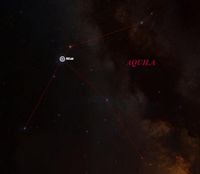Altair
 From Conservapedia
From Conservapedia | Altair | |
|---|---|

| |
| Observational Data | |
| Designation | Alpha Aquilae NSV 24910 |
| Right ascension | 19h 50m 46.9990s |
| Declination | +08o 52′ 05.959″ |
| Constellation | Aquila |
| Type of object | Star |
| Magnitude | Apparent Mag: 0.77 Absolute Mag: 2.21 |
| Astrometry | |
| Distance from Earth | 16.77 ly |
| Radial velocity | −26.1 ± 0.9 km/s |
| Proper motion | RA: 536.87 mas/yr Dec.: 385.57 mas/yr |
| Parallax | 194.45 ± 0.94 mas |
Altair, also known as Alpha Aquilae, is a spectral class A star located 16.8 light years away in the constellation Aquila as its brightest star. Altair is also the lower left member of the Summer Triangle. The star is the 12th brightest in the night sky with an apparent magnitude of 0.77,[1] making it readily visible to the unaided eye.
Altair in history[edit]
The common name of Altair is derived from the Arabic phase النسر الطائر, an-nasr aţ-ţā’ir or "The Flying Eagle", the name has been in use since the Medieval Era. Originally the Arabic phrase applied to the pattern Altair formed along with Beta and Gamma Aquilae. The idea of Altair as the eagle or as a part of the eagle possibly goes back to ancient Babylon or Sumeria, as both civilizations referred to the star as the eagle star.[2]
The Chinese referred to Altair itself as 河鼓二 (Hé Gŭ èr or Second Star of the Drum at the River) due to the asterism the star formed along with Beta and Gamma Aquilae called 河鼓 (Hé Gŭ or River Drum).[2] However the star was also commonly called 牛郎星 (Niú Láng Xīng or Star of the Cowhead), where it is associated with Chinese mythology in reference to the stars. In Japan, Altair has a similar name 彦星 (Hikoboshi, or Cow Herder Star), based on the same mythology.[3]
The Star[edit]
Altair is a white main sequence star of spectral class A7 V-IV.[1] The star is estimated to have some 1.7 times the mass of our sun, and 1.8 times its diameter.[4] Altair is also considerably brighter, with 10.7 times the visual luminosity of the Sun, even though much of the radiation from Altair is in the ultraviolet.
Altair is a metals-rich star. Using metallicity, the star is estimated to be twice as enriched as the Sun, based on its abundance of iron.[5] Dust has been also detected orbiting Altair.[6]
Altair has also be recently identified as variable star, and thus has the New Suspected Variable designation NSV 24910. The change in its magnitude is not possible to detect by the unaided eye. The variation occurs in nine different periods ranging from nine hours to a mere 50 minutes in length, and changes by only a few thousandths of a magnitude.[7]
One interesting aspect about Altair is the unusually fast rotational speed of 210 kilometers per second. The star rotates so quickly that it completes a rotation in some 10.4 hours. In comparison, the Sun takes 25.4 days to complete a rotation. As a result of this rapid rotation, the star is most likely shaped like a flattened ellipsoid, with an equatorial diameter some 14 percent greater than the diameter at the poles.[8]
So far, no substellar companions have been detected around Altair. Altair's habitable zone, where an Earth-like world could have liquid water on its surface, is centered around 3.4 AU.
References[edit]
- ↑ 1.0 1.1 http://simbad.u-strasbg.fr/simbad/sim-id?Ident=alf+aql
- ↑ 2.0 2.1 pp. 17–18, A Dictionary of Modern Star Names, Paul Kunitzsch and Tim Smart, Cambridge, Massachusetts: Sky Publishing, 2006, ISBN 978-1-931559-44-7.
- ↑ p. 72, China, Japan, Korea Culture and Customs: Culture and Customs, Ju Brown and John Brown, 2006, ISBN 9781419648939.
- ↑ Imaging the Surface of Altair, J. Monnier et al., Science 317, #5836 (July 20, 2007), pp. 342–345
- ↑ http://adsbit.harvard.edu/cgi-bin/nph-iarticle_query?bibcode=1992A&AS...95..273C
- ↑ http://adsabs.harvard.edu/cgi-bin/nph-bib_query?bibcode=1999A&A...350..603H&db_key=AST&high=3faa46c3cc22628
- ↑ http://stars.astro.illinois.edu/sow/altair.html
- ↑ Altair's Oblateness and Rotation Velocity from Long-Baseline Interferometry, Gerard T. van Belle, David R. Ciardi, Robert R. Thompson, Rachel L. Akeson, and Elizabeth A. Lada, Astrophysical Journal 559 (October 1, 2001), pp. 1155–1164, doi:10.1086/322340, Bibcode: 2001ApJ...559.1155
Categories: [Astronomy]
↧ Download as ZWI file | Last modified: 03/10/2023 16:43:35 | 15 views
☰ Source: https://www.conservapedia.com/Altair | License: CC BY-SA 3.0
 ZWI signed:
ZWI signed: KSF
KSF